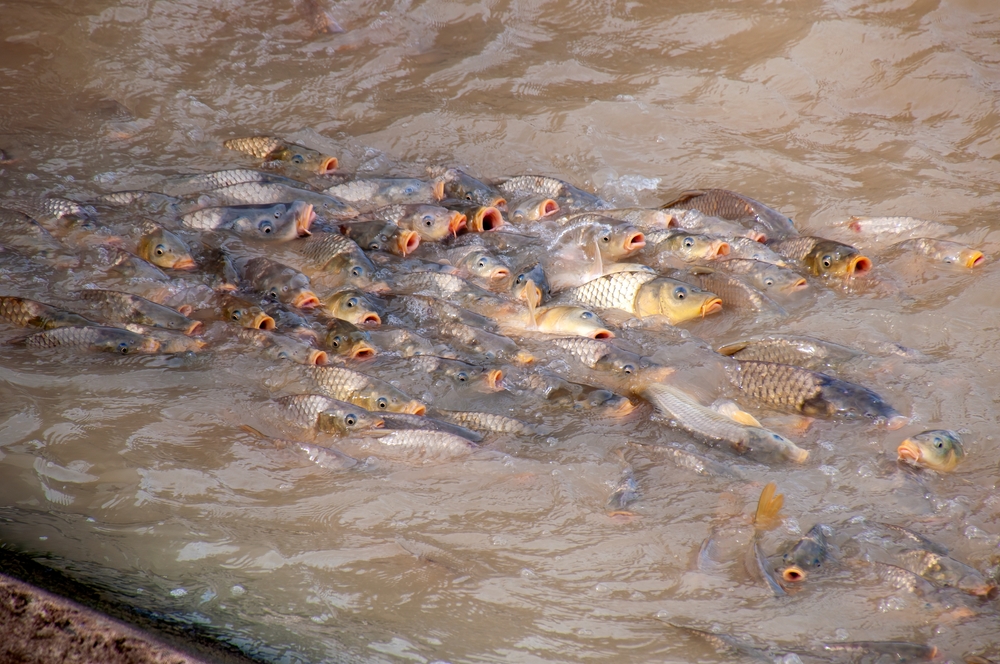European Carp (Cyrpinus carpio), or common carp, are an invasive freshwater pest of Australia’s inland waters.
Carp populations in Australia are increasing due to favourable climatic conditions. In infested rivers, carp numbers can be as high as 90% of biomass, outnumbering native fish species. High numbers cause muddy waters, kill aquatic plants and degrade freshwater ecosystems.
Carp are now in every state and territory in Australia except the Northern Territory.

A virus that kills carp may help
Controlling carp numbers is the responsibility of the state and territory governments.
Management programs include carp removal, native fish re-stocking, installing barriers, electrofishing, and trapping.
These methods are currently not enough to reduce carp numbers. More methods are needed to help reduce carp numbers.
Carp virus (Cyprinid herpesvirus 3) causes a fatal disease in carp.
Australian researchers are now looking at using this virus as a possible solution to reducing carp populations. This type of solution is "biological control" or "biocontrol". Before we can use the virus in Australia, we must be sure that it will not harm native fish or Australia’s ecosystems.
Previous research to understand the virus
In Australia, viruses must undergo testing before they are used as biocontrol agents.
A program of carp virus research called the National Carp Control Plan (NCCP) has been completed.
The NCCP was led by Fisheries Research and Development Corporation. It included specialised virus research, consultation and investigations.
The NCCP final report, published in November 2022, is a huge volume of high-quality research and analysis.
The report suggests the carp virus could reduce Australian carp populations by 40-80%. It also identified questions about the safe release of the virus. More research was recommended before a decision could be made.
The current program of carp virus research
In 2023, Australian Agriculture Ministers approved more research. The new research includes 7 Priority Research Actions. These actions are:
- Further testing of four fish species to ensure only carp are affected by the virus. Many other species were tested before as part of the NCCP.
- Understand impacts on threatened species, communities, and river systems.
- Examine ecological factors affecting transmissibility of the carp virus.
- Understand how effective the carp virus is in the river systems.
- Conduct a cost-benefit analysis.
- Verify epidemiological modelling to better predict the spread of the virus.
- Consider using conventional carp control methods together with the carp virus.
When completed, this research will improve knowledge and understanding of the carp virus for use as a biocontrol agent. It is likely the research will take several years to complete.
The research will be guided by the Carp Scientific Advisory Group - a committee of Australian and international subject matter experts. The committee meets regularly to guide research requirements and to interpret research results.
We will provide updates as each research activity is finished.
To find out more visit the Carp Scientific Advisory Group page.
Regulatory and Ministerial approvals
Releasing the virus into the environment requires assessments and approvals from Commonwealth regulators. Regulatory assessments consider the risks, benefits, safety, and effectiveness of releasing the virus. These assessments make sure that the virus is safe to use and will deliver valued benefit. It also ensures that planning is in place to minimise and manage any potential risks.
Regulatory officials will conduct assessments in compliance with the following legislation:
- Agricultural and Veterinary Chemicals Code Act (1994)
- Biosecurity Act (2015)
- Biological Control Act (1984)
- Environment Protection and Biodiversity Conservation Act (1999)
- Water Act (2007)
Each state and territory will also need local approvals before releasing the virus.
Carp Biological Control Program management
The Environmental Biosecurity Office will manage the program. The Carp Scientific Advisory Group and the Environment and Invasives Committee will provide advice.
The Agriculture Minsters’ Meeting will oversee the Carp Biological Control Program. They will make the final decision to release or not release the virus in the field.
Releasing and using the virus in Australia to control carp in our rivers is dependent on several crucial steps including:
- Satisfactory completion of scientific research
- Commonwealth regulatory agency approvals
- State and territory regulatory approvals
- Implementation planning
- Community consultation
- Agreement from state, territory and Commonwealth Agriculture Ministers.
Cost and timeline of the Carp Biological Control Program
In 2016, the Commonwealth allocated $15 million to investigate the feasibility of using the carp virus in Australia. The funds paid for:
- The National Carp Control Plan (2016-2022) program.
- Publishing the National Carp Control Plan (NCCP) report (2022),
- Support a smaller program of extra research to answer questions identified in the NCCP (2024-2027).
The program of extra research will take 2-3 years. Assessment by regulatory agencies will also take several years but most of that time will overlap with the research period.
Stakeholder consultation
Consultation will continue to provide updates and opportunities for feedback. This information will be shared through many stakeholder networks.
You can register for updates through the Environmental Biosecurity Office.
Carp virus field trial proposal
A DAFF working group initiated at the request of Victorian fisheries officials, will develop a proposal for a field trial using the carp virus. The working group includes fisheries officials from Victoria, New South Wales, South Australia, and Queensland. The purpose of the proposed field trial is to assess the efficacy of the carp virus under natural conditions. Regulatory approval will be required to manage risks before field trials can start. The field trial proposal is being developed in parallel to the Carp Biological Control Program.
Find out more
- Read The National Carp Control Plan
- Watch the ‘Next Phase for Carp Biocontrol’ Webinar
- Get updates from the Carp Scientific Advisory Group.
- Contact the Environmental Biosecurity Office.
